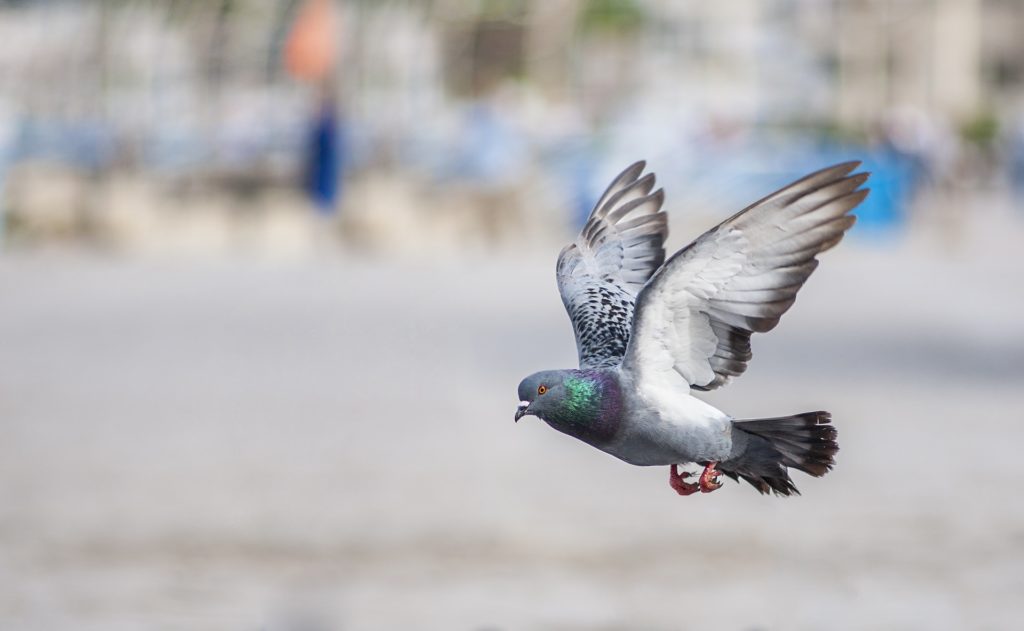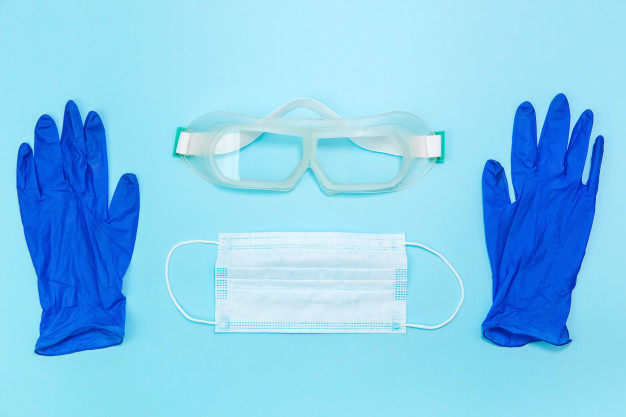According to a popular theory, pigeons don’t poop while in flight and can be quite selective when it comes to going number 2.
That’s why we see clusters of pigeon poop on the window sills, decks, statues or wherever those fussy little poopers are hanging out.

Some experts believe that pigeons don’t poop while in flight because of the way they tuck their feet against their body while flying. The tuck would mean that if they did poop while in flight, it would go all over their feet, so they don’t.
In my opinion, that’s great news! The fewer poop bombs falling from above, the better! If you’ve ever been the “lucky” target of a bird poop bomb you know what I mean!
The only downside is, we’re left to clean up the mess.
So how do we properly clean the pigeon poop?…
The short answer, very carefully!
Ingested pigeon poop can lead to several diseases in humans, such as; Salmonella (bacterial infection), Psittacosis (flu like illness), Diarrhea, Histoplasmosis (respiratory disease), to name a few.
Pigeon poop carries pathogens that are harmful to humans when ingested. Touching pigeon poop (when cleaning it or accidentally like on a bench etc) and then using your phone or scratching your face or rubbing your eye are all easy ways to accidentally ingest. Breathing in the dry poop particles floating in the air is another way to ingest.
Wearing Personal Protective Equipment (PPE) when cleaning up pigeon poop is a must!

The 3 pieces of PPE we recommend for cleaning pigeon poop are gloves, glasses and a mask. Especially if you’re removing a large amount, and especially if the poop is dry. It’s very easy to breathe in the particles and they are toxic!
Once you’ve dawned your PPE, it’s time to start cleaning!
*friendly reminder – These are helpful suggestions to remove pigeon poop around the house, on window sills, handrails, tables, the deck, etc. For larger or heavily soiled areas you may need bigger tools like brooms, hoses or even pressure washers. You may even need more PPE like a bodysuit and respirator. Be cautious and contact a professional cleaning or maintenance company if you’re unsure.
Solutions:
When it comes to the solution, choose wisely. Your choice for the perfect solution should include the following considerations:
What surface is the poop on and what products may damage the surface?
Pigeon poop is very acidic and will cause damage to most surfaces if left on long enough. That being said, we don’t want to cause more damage to the surface by choosing the wrong product to remove the poop with. Even dish soap can be damaging to some surfaces so make sure you read the instructions, ask for help and always test before using a product, especially if you’re not familiar with it.
Is there enough ventilation in the area to use this solution?
Some products like bleach are very strong and not healthy to breath in large amounts. Make sure the area you’re cleaning is properly ventilated before starting.
Am I using the right PPE for the solution?
Read the label carefully! Make sure you’re using the proper PPE for the Product!
Over the counter Disinfectants and household cleaners can be useful. Some are better than others. If you have one you stand behind, by all means use it. We always recommend testing unfamiliar products before using them.
3 House Hold Solutions to Clean and Disinfect Pigeon Poop
Bleach
This is our first choice when it comes to household disinfectants. It’s the most powerful disinfectant in this list, but it can be damaging to some surfaces. Bleach should always be diluted with water before use. For this purpose we recommend mixing a solution of ½ cup bleach to 1 gallon of water.
Misting will help settle suspended air-born particlesSoak the area and let it sit for 15 mins to disinfect and soften the poop (reapply solution if it starts to dry during the 15 mins) , heavily soiled areas may require multiple applications. Wipe or Scrape away the poop and place into a doubled plastic bag and seal it. Properly seal and dispose of the bag making sure it’s away from direct human contact human
Laundry Detergent
Laundry detergent will help disinfect the area and may not be as damaging to the surface or surrounding area as bleach. Some detergents have bleach in them so make sure to read the label and always test a small amount on a small unnoticeable area before starting.
For this purpose we recommend mixing a solution of about 1 tbsp of laundry detergent with 2 cups of warm water. Make sure all the detergent is dissolved in the water before use.
Similar to bleach, misting will help settle suspended air-born particles. Soak the area and let it sit for 15 mins to disinfect and soften the poop (reapply solution if it starts to dry during the 15 mins) Wipe or scrape the poop away, repeat the process for heavily soiled areas. Place the poop in a double plastic bag, seal it and safely discard.
Vinegar
Bleach and laundry detergent can be harmful to some surfaces and the environment. That’s why using vinegar can be handy, it’s the green solution. The vinegar acts as an excellent disinfect for the area. Similar to bleach, vinegar should always be diluted. For this purpose we recommend a 50/50 solution of vinegar and water.
It’s important to remember that vinegar can still be damaging especially to wood, if left on too long. It can soak into wood very easily, causing it to stain. Vinegar is used as a stain for wood and the results can be great, however if that’s not the intention vinegar stain can be very damaging.
Apply with a cloth or in a mist. Wipe or scrape the poop away, repeat the process for heavily soiled areas. Place the poop in a double plastic bag, seal it and safely discard.
These solutions may not remove all the stains from pigeon poop, but it will help clean and disinfect the area. Pigeon poop can cause permanent damage to surfaces if left on long enough especially if it’s baked in by the sun. The best way to avoid damage is to clean it as soon as you notice it.
We hope these tips help, thanks for reading!